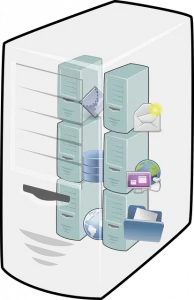In today’s digital era, cloud computing has become the backbone for businesses and individuals seeking to power their applications, websites, and services. The availability of numerous cloud providers has undoubtedly made the selection process a bit overwhelming. Determining the ideal provider that aligns with your specific needs can feel like finding a needle in a haystack. Fear not, for we’re here to help! Allow us to introduce you to four popular contenders in the cloud computing market: AWS, DigitalOcean, Cloud, and Vultr. Each of these providers brings a unique set of features and capabilities to the table, catering to different use cases.
In this captivating blog post, we’re about to embark on a comprehensive comparison journey of these platforms. We’ll delve into the depths of their differences, uncover their strengths and weaknesses, and equip you with the knowledge necessary to make an informed decision when selecting a cloud provider for your projects. Whether you’re a fresh-faced startup, a small business aiming to expand, or an established enterprise seeking to optimize operations, choosing the right cloud provider is crucial to meet your specific requirements. This blog post aims to provide you with invaluable insights to navigate the labyrinthine world of AWS, DigitalOcean, UpCloud, and Vultr.
So, fasten your seatbelt as we embark on this thrilling adventure of exploring the distinctions between these remarkable cloud platforms. Together, we’ll uncover the secrets and help you discover the perfect match for your unique cloud computing needs. Get ready to dive in and unearth the ideal cloud provider for your projects!
Parameters of Differences Between AWS, DigitalOcean, Google Cloud and Vultr:
| Parameter | AWS | DigitalOcean | Google Cloud | Vultr |
| Service Offerings | Vast range of services | Simplified services | Comprehensive services | Compute instances |
| Scalability | Extensive options | Limited options | Robust scalability | Basic scalability |
| Pricing Models | Flexible pricing options | Fixed pricing | Various pricing models | Hourly/Monthly billing |
| User Interface | Complex interface | User-friendly interface | User-friendly interface | User-friendly interface |
| Community and Support | Extensive support | Active community | Large community | Community support |
| Global Infrastructure | Extensive availability | Limited availability | Robust availability | Global data centers |
| Managed Services | Broad range of options | Limited managed services | Extensive managed services | Infrastructure-focused |
| Additional Services | Extensive offerings | Additional services | Additional services | Core infrastructure |
| Integration with Tools | Extensive integration | Limited integration | Integration with tools | Limited integration |
1. Service Offerings:

AWS (Amazon Web Services): Amazon Web Services (AWS) offers a vast range of services to meet diverse cloud computing needs. AWS provides solutions for compute power, storage, databases, machine learning, analytics, networking, content delivery, security, and more. It includes services like Amazon EC2 for virtual servers, Amazon S3 for scalable object storage, Amazon RDS for managed databases, Amazon Redshift for data warehousing, AWS Lambda for serverless computing, Amazon EMR for big data processing, and AWS IoT for Internet of Things applications. AWS has a wide array of services that cater to various industries and use cases, making it a comprehensive and versatile cloud platform. Deep dive into AWS here.
DigitalOcean: DigitalOcean focuses on simplicity and provides a streamlined set of services aimed at developers and startups. The core service offering of DigitalOcean revolves around Droplets, which are virtual machines that can be quickly deployed and scaled. Droplets provide compute power, and developers can choose from various configurations based on their requirements. DigitalOcean also offers managed databases (Managed Databases) for easy database management, load balancers to distribute traffic, object storage (Spaces) for storing and serving static assets, and monitoring tools (Monitoring and Alerts) to track performance and health of resources. DigitalOcean’s straightforward and easy-to-use services make it popular among developers seeking simplicity and efficiency. Learn about it here.
Google Cloud: Google Cloud Platform (GCP) provides a comprehensive suite of services comparable to AWS and focuses on enabling businesses to leverage the power of Google’s infrastructure. GCP offers services for computing, storage, networking, databases, machine learning, data analytics, identity management, and more. GCP services include Compute Engine for virtual machines, Cloud Storage for object storage, Cloud SQL for managed databases, BigQuery for analytics, Google Kubernetes Engine (GKE) for container orchestration, and various APIs for integration. Google Cloud also provides AI/ML services, such as AutoML for custom machine learning models and AI Platform for managing and deploying ML models. GCP’s extensive range of services caters to enterprise customers, developers, and data-driven organizations.
Vultr: Vultr is a cloud provider that primarily focuses on infrastructure services. It offers compute instances, block storage, dedicated cloud servers, and managed Kubernetes services. Vultr’s compute instances are virtual machines that provide processing power, memory, and storage resources. Users can choose from different instance types based on their requirements. Vultr’s block storage enables users to attach additional storage to their instances. The dedicated cloud servers offer bare metal performance with dedicated hardware resources. Vultr also provides managed Kubernetes services, allowing users to deploy and manage containerized applications using Kubernetes orchestration. Vultr’s offerings are geared towards users looking for reliable and scalable infrastructure services.
2. Scalability:

AWS (Amazon Web Services): AWS offers extensive scalability options to meet the demands of high-demand workloads. One of the key features for scalability in AWS is Auto Scaling Groups. Auto Scaling allows users to automatically adjust the number of instances based on predefined conditions or metrics. This ensures that the application can handle fluctuations in traffic and maintain performance and availability. Additionally, Elastic Load Balancing distributes incoming traffic across multiple instances, enabling horizontal scaling by adding or removing instances as needed. AWS also provides services like AWS Elastic Beanstalk, AWS App Runner, and AWS Fargate that simplify the deployment and management of scalable applications. These features and services make AWS a highly scalable platform suitable for handling workloads of varying sizes and traffic patterns.
DigitalOcean: DigitalOcean offers limited scalability options compared to AWS. The primary scalability option in DigitalOcean is vertical scaling, which involves upgrading the resources of the existing Droplets (virtual machines). Users can easily resize their Droplets to increase the CPU, memory, and storage capacity of the instances. However, DigitalOcean does not provide native horizontal scaling features like auto-scaling groups. To achieve horizontal scalability on DigitalOcean, users need to manually create additional Droplets and distribute the load across them using load balancers or other third-party solutions. While DigitalOcean’s scalability options may be simpler and more accessible for smaller workloads, it may require more manual intervention for handling rapid scaling needs.
Google Cloud: Google Cloud Platform (GCP) offers robust scalability options similar to AWS. Managed Instance Groups (MIGs) in GCP allow users to create groups of instances and automatically scale them based on defined criteria such as CPU utilization or HTTP load balancing. MIGs can automatically add or remove instances to handle fluctuations in traffic and ensure optimal performance. GCP also provides Autoscaling policies which dynamically adjust the number of instances in response to changes in demand. Load Balancing in GCP ensures that traffic is distributed evenly across instances, allowing for horizontal scaling by adding or removing instances behind the load balancer. GCP’s scalability features, coupled with its global infrastructure, enable seamless scaling to meet varying workload demands.
Vultr: Vultr provides basic scalability features for compute instances. Users can scale their instances vertically by upgrading the resources such as CPU, memory, and storage capacity. Vultr also supports horizontal scaling, where users can create additional compute instances and distribute the workload across them manually. However, Vultr does not offer built-in auto-scaling features or managed scaling options like AWS or Google Cloud. Users have to monitor the workload and adjust the number of instances manually to accommodate changes in demand. Vultr’s scalability options are more straightforward and suitable for smaller-scale applications or workloads with predictable traffic patterns.
3. Pricing Models:

AWS (Amazon Web Services): AWS offers a flexible pricing model with various options to accommodate different usage patterns. The most common pricing model in AWS is pay-as-you-go, where users are billed based on their actual usage of AWS services. This model is ideal for applications with dynamic or unpredictable workloads. AWS also provides Reserved Instances, which allow users to reserve capacity for a specific term (1 or 3 years) and receive a significant discount compared to pay-as-you-go rates. Reserved Instances are suitable for applications with steady workloads or predictable usage. Additionally, AWS offers Spot Instances where users can bid on unused capacity and potentially get access to compute resources at significantly lower prices. Spot Instances are ideal for applications that can handle interruptions or have flexible processing requirements.
DigitalOcean: DigitalOcean follows a fixed pricing model, offering transparent and predictable pricing based on Droplet configurations. Droplets are virtual machines offered by DigitalOcean, and their pricing is based on the chosen CPU, memory, storage, and bandwidth specifications. DigitalOcean provides a pricing calculator on their website, allowing users to estimate the costs of their desired Droplet configurations. In addition to Droplet pricing, DigitalOcean offers additional services such as Managed Databases, Block Storage, and Networking, which have separate pricing based on usage. DigitalOcean’s fixed pricing model simplifies cost estimation and budgeting for users.
Google Cloud: Google Cloud Platform (GCP) provides multiple pricing models to suit different user needs. The pay-as-you-go model is the default pricing option in GCP, where users are billed based on their actual usage of resources and services. GCP also offers Sustained Use Discounts, which provide automatic discounts for workloads that run for a significant portion of the billing month. Committed Use Discounts are available for users who commit to using specific resources for one or three-year terms, offering substantial discounts compared to pay-as-you-go rates. Additionally, GCP provides Preemptible VMs, which are instances available at significantly lower prices but can be interrupted at any time. These pricing models in GCP provide users with flexibility and cost optimization options based on their workload requirements.
Vultr: Vultr follows a straightforward pricing model based on hourly or monthly usage. Users are billed for the compute instances they deploy on Vultr’s platform. The pricing is tiered based on the compute instance configurations, including CPU, memory, storage, and bandwidth specifications. Vultr provides a pricing page on their website, allowing users to estimate the costs based on their desired compute instance configuration and usage duration. Vultr’s pricing model is transparent and predictable, providing users with clarity on their expenses and flexibility in managing their budget.
4. User Interface and Ease of Use:

AWS (Amazon Web Services): AWS provides a comprehensive set of cloud services, but its web console can be complex, especially for beginners. The AWS Management Console offers a wide range of functionalities and features, which may require some time and effort to navigate and understand. While it provides extensive capabilities for managing cloud resources, configuring services, and monitoring applications, users with limited experience may find the learning curve to be steeper compared to other providers. Explore AWS Management Console
DigitalOcean: DigitalOcean stands out with its user-friendly and intuitive interface. The DigitalOcean Control Panel offers a streamlined and simplified experience, making it easier for users to deploy, configure, and manage their cloud resources. The interface is designed with simplicity in mind, allowing users to quickly navigate through various options, create Droplets (virtual machines), configure networking, and manage additional services. DigitalOcean’s user-friendly interface makes it an attractive choice, especially for developers and small businesses who prioritize ease of use. Experience DigitalOcean Control Panel
Google Cloud: Google Cloud Platform (GCP) provides a user-friendly interface that simplifies the management of cloud services and resources. The GCP Console offers an intuitive layout and navigation, allowing users to easily access and manage various services. The interface provides clear organization and categorization of resources, making it straightforward to create virtual machines, set up networking, configure storage, and manage other cloud components. Google Cloud’s user-friendly interface contributes to a positive user experience and facilitates efficient management of cloud resources. Navigate Google Cloud Console
Vultr: Vultr offers a straightforward and user-friendly interface for deploying and managing cloud instances. The Vultr Control Panel is designed to be simple and intuitive, enabling users to quickly spin up compute instances, manage storage, configure networking, and access additional features. The interface provides a clear and concise layout, making it easy for users to find the desired options and perform necessary tasks without unnecessary complexities. Vultr’s user-friendly interface caters to users who value simplicity and ease of use. Access Vultr Control Panel
5. Community and Support:

AWS (Amazon Web Services): AWS has a vast user community and offers extensive documentation to assist users in understanding and utilizing their services. The AWS community comprises a large user base, including developers, system administrators, and industry professionals, who actively engage in forums, discussion boards, and social media groups. This community provides a valuable resource for sharing knowledge, best practices, and troubleshooting tips. AWS also offers multiple support plans to cater to different needs. The basic support plan is available for free and provides access to documentation, forums, and customer service via email. Additionally, AWS offers premium support plans that include 24/7 access to technical support, faster response times, and personalized guidance from AWS experts.
DigitalOcean: DigitalOcean has an active and supportive community that contributes to forums, online communities, and tutorials. The community provides a platform for users to exchange ideas, seek assistance, and share their experiences. DigitalOcean also provides comprehensive documentation that covers various topics, including getting started guides, API references, and troubleshooting resources. In terms of support, DigitalOcean offers 24/7 technical support through their ticketing system. Users can submit support tickets for assistance with technical issues or inquiries. The ticketing system ensures that users receive timely responses from the DigitalOcean support team.
Google Cloud: GCP has a large and active user community that actively participates in forums, online communities, and developer groups. This community engagement fosters knowledge sharing, collaboration, and problem-solving among users. Google Cloud also provides extensive documentation, including guides, tutorials, and API references, to help users understand and implement their services effectively. In terms of support, Google Cloud offers various options. Users can access free support, which includes access to documentation, forums, and billing support. Additionally, Google Cloud offers paid support plans that provide 24/7 technical support, faster response times, and additional benefits based on the chosen plan.
Vultr: Vultr has an active user community that engages in discussions, forums, and social media platforms, allowing users to seek advice and share their experiences. The community-driven interaction enables users to find solutions and gain insights from others’ experiences. Vultr also provides support through their ticketing system, where users can submit support tickets for assistance. The support team responds to these tickets to address technical issues or inquiries. Furthermore, Vultr offers a knowledge base with extensive documentation that covers various topics related to their services, providing self-help resources to users. However, it’s worth noting that Vultr does not offer phone or live chat support, and users primarily rely on ticket-based communication for support.
6. Global Infrastructure and Availability Zones:

AWS (Amazon Web Services): AWS boasts an extensive global infrastructure with data centers located in regions worldwide. Each region consists of multiple availability zones (AZs), which are physically separate data centers designed to provide high availability and redundancy. Availability zones within a region are interconnected through low-latency links, enabling users to build highly resilient and fault-tolerant applications. The presence of multiple availability zones allows users to distribute their resources across different zones, minimizing the impact of failures and ensuring continuous operation even in the event of disruptions or outages. AWS’s global infrastructure offers users the flexibility to deploy their applications and services in various regions, catering to diverse geographical needs. Learn more about AWS Global Infrastructure
DigitalOcean: DigitalOcean operates data centers in various regions, providing users with the flexibility to choose the location that best suits their needs. However, DigitalOcean’s infrastructure is relatively smaller compared to providers like AWS and Google Cloud. While DigitalOcean has multiple data centers, the number of availability zones within each region is limited. This means that users may have fewer options for distributing their resources across different availability zones, potentially affecting the level of redundancy and fault tolerance in their deployments. Nonetheless, DigitalOcean ensures reliable and performant services within their data centers, catering to the needs of developers and small businesses. Explore DigitalOcean’s Data Centers
Google Cloud: Google Cloud Platform (GCP) maintains a robust global infrastructure with data centers strategically located across regions worldwide. Similar to AWS, each region in Google Cloud consists of multiple availability zones, ensuring high availability and disaster recovery capabilities. The presence of multiple availability zones allows users to design and deploy their applications for resilience and fault tolerance. Google Cloud’s global infrastructure enables users to distribute their workloads geographically, providing low-latency access to their services for users located in different regions. The extensive network of availability zones enhances the reliability and scalability of applications hosted on Google Cloud. Discover Google Cloud Infrastructure
Vultr: Vultr operates a global network of data centers, providing users with the option to deploy their applications in different regions. However, the number of regions and availability zones offered by Vultr is relatively smaller compared to providers like AWS and Google Cloud. This means that users may have fewer choices in terms of geographical distribution and fault tolerance. Despite this, Vultr ensures reliable and efficient services within their data centers, catering to the needs of developers, businesses, and individuals looking for a global presence with a more streamlined infrastructure. Learn more about Vultr’s Data Centers
7. Managed Services:

AWS (Amazon Web Services): AWS offers an extensive array of managed services, providing users with a wide range of options to leverage pre-configured and fully managed solutions. Some notable managed services offered by AWS include:
- Managed Databases (Amazon RDS): AWS provides managed database services for various database engines like MySQL, PostgreSQL, Oracle, and SQL Server. With Amazon RDS, users can offload the management tasks of database administration, backups, patching, and scaling to AWS.
- Serverless Computing (AWS Lambda): AWS Lambda allows users to run their code without provisioning or managing servers. It enables developers to build scalable and event-driven applications, automatically managing infrastructure resources as per demand.
- Container Orchestration (Amazon ECS / EKS): AWS offers managed container orchestration services with Amazon Elastic Container Service (ECS) and Amazon Elastic Kubernetes Service (EKS). These services simplify the deployment, scaling, and management of containerized applications.
- AI/ML Services (Amazon SageMaker): AWS provides a comprehensive set of AI/ML services through Amazon SageMaker. Users can build, train, and deploy machine learning models using pre-built algorithms and frameworks.
DigitalOcean: DigitalOcean offers a limited but focused set of managed services to simplify the deployment and management of specific components. Some key managed services offered by DigitalOcean include:
- Managed Databases (Managed Databases): DigitalOcean provides managed database services for popular database engines like PostgreSQL, MySQL, and Redis. These services handle tasks such as database setup, backups, and scaling, reducing the operational burden on users.
- Container Orchestration (Kubernetes): DigitalOcean offers a managed Kubernetes service that simplifies the deployment and management of containerized applications. Users can leverage the power of Kubernetes without the need for manual infrastructure management.
- Google Cloud: Google Cloud emphasizes its suite of managed services, providing users with pre-configured and fully managed solutions for various components. Some notable managed services offered by Google Cloud include:
- Managed Databases (Cloud SQL): Google Cloud offers managed database services through Cloud SQL, supporting databases like MySQL, PostgreSQL, and SQL Server. These services handle tasks such as database management, patching, backups, and scaling.
- Serverless Computing (Cloud Functions): Google Cloud’s Cloud Functions allows users to build and deploy event-driven serverless applications. It abstracts away the infrastructure management, enabling developers to focus solely on writing code.
- Container Orchestration (GKE): Google Kubernetes Engine (GKE) is a managed Kubernetes service that simplifies the deployment, management, and scaling of containerized applications. GKE automates infrastructure tasks, ensuring high availability and scalability.
- AI/ML Services (AI Platform): Google Cloud provides AI/ML services through its AI Platform. It offers a range of tools and APIs for building and deploying machine learning models, including pre-trained models and AutoML capabilities.
Vultr: Vultr primarily focuses on infrastructure services and does not offer as many managed services compared to AWS and Google Cloud. While Vultr provides a reliable cloud infrastructure for deploying virtual machines and storage, it does not have an extensive portfolio of managed services. Vultr’s offerings cater more towards users who prefer greater control and flexibility over their infrastructure, rather than relying on fully managed solutions.
8. Additional Services:
AWS (Amazon Web Services): In addition to its core cloud services, AWS provides a vast array of additional services to enhance the capabilities of applications and infrastructure. Some notable additional services offered by AWS include:
- Content Delivery Networks (Amazon CloudFront): AWS CloudFront is a globally distributed content delivery network (CDN) that helps deliver content, including web pages, videos, and other files, to users with low latency and high transfer speeds.
- Messaging Services (Amazon SQS): Amazon Simple Queue Service (SQS) is a fully managed message queuing service that enables decoupling and scaling of distributed systems. It provides reliable and scalable message queuing for building asynchronous and fault-tolerant applications.
- Notification Services (Amazon SNS): Amazon Simple Notification Service (SNS) is a fully managed messaging service that enables the sending and receiving of notifications. It supports multiple messaging protocols and allows applications to send notifications to various endpoints, including mobile devices, email, and HTTP/S endpoints.
- Database Migration (AWS Database Migration Service): AWS Database Migration Service (DMS) simplifies the migration of databases to AWS. It supports both homogenous and heterogeneous database migrations, making it easier to move databases from on-premises or other cloud platforms to AWS.
DigitalOcean: DigitalOcean offers a selection of additional services to complement its core infrastructure offerings. These services focus on providing developers with the necessary tools and features to build and manage their applications effectively. Some notable additional services offered by DigitalOcean include:
- Managed Kubernetes (DigitalOcean Kubernetes): DigitalOcean provides a managed Kubernetes service that simplifies the deployment, scaling, and management of containerized applications using the popular Kubernetes orchestration platform.
- Object Storage (DigitalOcean Spaces): DigitalOcean Spaces is an object storage service that allows users to store and serve large amounts of unstructured data, such as images, videos, and backups. It provides an S3-compatible API for seamless integration with existing applications.
- Block Storage (DigitalOcean Volumes): DigitalOcean Volumes is a flexible and scalable block storage service that provides additional storage for Droplets (virtual machines). Users can attach and detach volumes to their Droplets as needed, expanding storage capacity for applications.
- Monitoring and Alerts (DigitalOcean Monitoring): DigitalOcean offers built-in monitoring and alerting capabilities to help users track the performance and health of their infrastructure. It provides insights into Droplet metrics, customizable alerts, and integration with popular monitoring tools.
Google Cloud: Google Cloud offers a wide range of additional services to complement its core cloud offerings, focusing on areas such as data analytics, messaging, event-driven computing, and serverless compute. Some notable additional services offered by Google Cloud include:
- Data Analytics (BigQuery): Google BigQuery is a fully managed data warehouse and analytics platform that allows users to run fast, SQL-like queries on massive datasets. It offers scalable and cost-effective analytics capabilities for extracting insights from large volumes of data.
- Messaging Services (Pub/Sub): Google Cloud Pub/Sub is a globally distributed messaging service that enables the decoupling of applications and microservices. It provides reliable and asynchronous communication between components, facilitating event-driven architectures.
- Event-Driven Computing (Cloud Pub/Sub): Google Cloud Pub/Sub allows developers to build event-driven applications that react to real-time events and triggers. It provides a scalable and reliable messaging backbone for handling event streams at any scale.
- Serverless Compute (Cloud Functions): Google Cloud Functions is a serverless compute platform that allows developers to write and deploy event-driven functions in multiple programming languages. It abstracts away the infrastructure management, allowing developers to focus solely on writing code.
Vultr: Vultr primarily focuses on core infrastructure services and does not offer an extensive range of additional services like AWS and Google Cloud. Its offerings are centered around providing reliable and scalable infrastructure components such as compute instances and storage. While Vultr may not provide as many additional services as other providers, its focus on core infrastructure appeals to users who prefer simplicity and flexibility in managing their resources.
9. Integration with Third-Party Tools:

AWS: AWS has established itself as a leader in cloud computing and boasts a vast ecosystem of third-party integrations. It offers extensive flexibility and compatibility by providing integration with numerous tools and services. This includes popular DevOps tools like Jenkins, Chef, and Puppet for continuous integration and deployment, as well as monitoring and logging tools like Datadog and Splunk for infrastructure monitoring and analytics. AWS also integrates seamlessly with other AWS services, allowing users to build comprehensive solutions using a combination of services within the AWS ecosystem.
DigitalOcean: DigitalOcean provides integrations with popular tools and services, although its ecosystem may not be as extensive as AWS. It offers integrations with widely-used developer tools such as GitLab, GitHub, and Docker, making it easier for developers to leverage their existing workflows. DigitalOcean also provides pre-configured one-click applications, allowing users to quickly deploy popular applications like WordPress, MongoDB, and Node.js with ease. While DigitalOcean’s integrations cover essential areas, the range of available integrations may be more limited compared to AWS.
Google Cloud: Google Cloud leverages Google’s extensive ecosystem and partnerships to offer seamless integrations with various third-party tools and services. It integrates well with popular development tools like GitHub, Jenkins, and Bitbucket, enabling streamlined workflows and continuous integration and deployment. Google Cloud also integrates with other Google services such as Google Analytics, Google BigQuery, and Google Cloud AI, allowing users to leverage Google’s advanced analytics and machine learning capabilities within their cloud infrastructure. This ecosystem integration provides users with a cohesive and comprehensive cloud computing experience.
Vultr: Vultr offers some integrations, although its options may be more limited compared to AWS and Google Cloud. It provides integration with popular tools like Terraform and Ansible for infrastructure provisioning and automation. Vultr also offers integrations with Content Delivery Networks (CDNs) like Cloudflare to enhance the performance and scalability of web applications. While Vultr’s integrations cover essential areas, it may not have the same breadth and depth of integrations as AWS and Google Cloud.
Conclusion:
Computing technologies have revolutionized the way businesses and individuals store, access, and process data. Whether it’s IaaS, PaaS, SaaS, serverless computing, containerization, or hybrid cloud, organizations have a range of options to choose from based on their specific requirements and objectives. Embracing cloud computing technologies empowers businesses to innovate, accelerate growth, and stay ahead in today’s digital landscape.
FAQs:
Which cloud provider should I choose among AWS, DigitalOcean, UpCloud, and Vultr?
The choice of cloud provider depends on your specific needs and requirements. Here are some factors to consider:
- Scale and breadth of services: If you require a comprehensive suite of services and global scalability, AWS is a good choice. It offers a vast array of services and caters to businesses of all sizes.
- Developer-friendliness and simplicity: If you value simplicity, user-friendly interfaces, and a developer-focused experience, DigitalOcean and Vultr are popular choices. They provide straightforward solutions and competitive pricing.
- Performance and reliability: If performance and reliability are your top priorities, UpCloud offers high-performance cloud servers and a focus on uptime.
- Cost-effectiveness: Pricing models vary among providers. AWS offers flexibility but can be costlier for certain workloads. DigitalOcean and Vultr are known for their affordability and transparent pricing.
Consider evaluating your specific requirements, the features offered by each provider, pricing models, customer support, and the overall reputation in the industry. It can be helpful to try out their services through free trials or small deployments before committing to a specific provider.
Can I migrate my applications or data between these cloud providers?
Yes, it is possible to migrate applications and data between different cloud providers, including AWS, DigitalOcean, UpCloud, and Vultr. However, the ease of migration may vary depending on the specific services and configurations you have in place. Most cloud providers offer tools and documentation to facilitate migrations, such as import/export functionalities, migration guides, and third-party tools. However, it is essential to consider potential differences in services, APIs, and configurations between providers, which might require some modifications or adjustments during the migration process. It is recommended to consult the documentation and support resources provided by each cloud provider and, if needed, seek professional assistance to ensure a smooth and successful migration.



